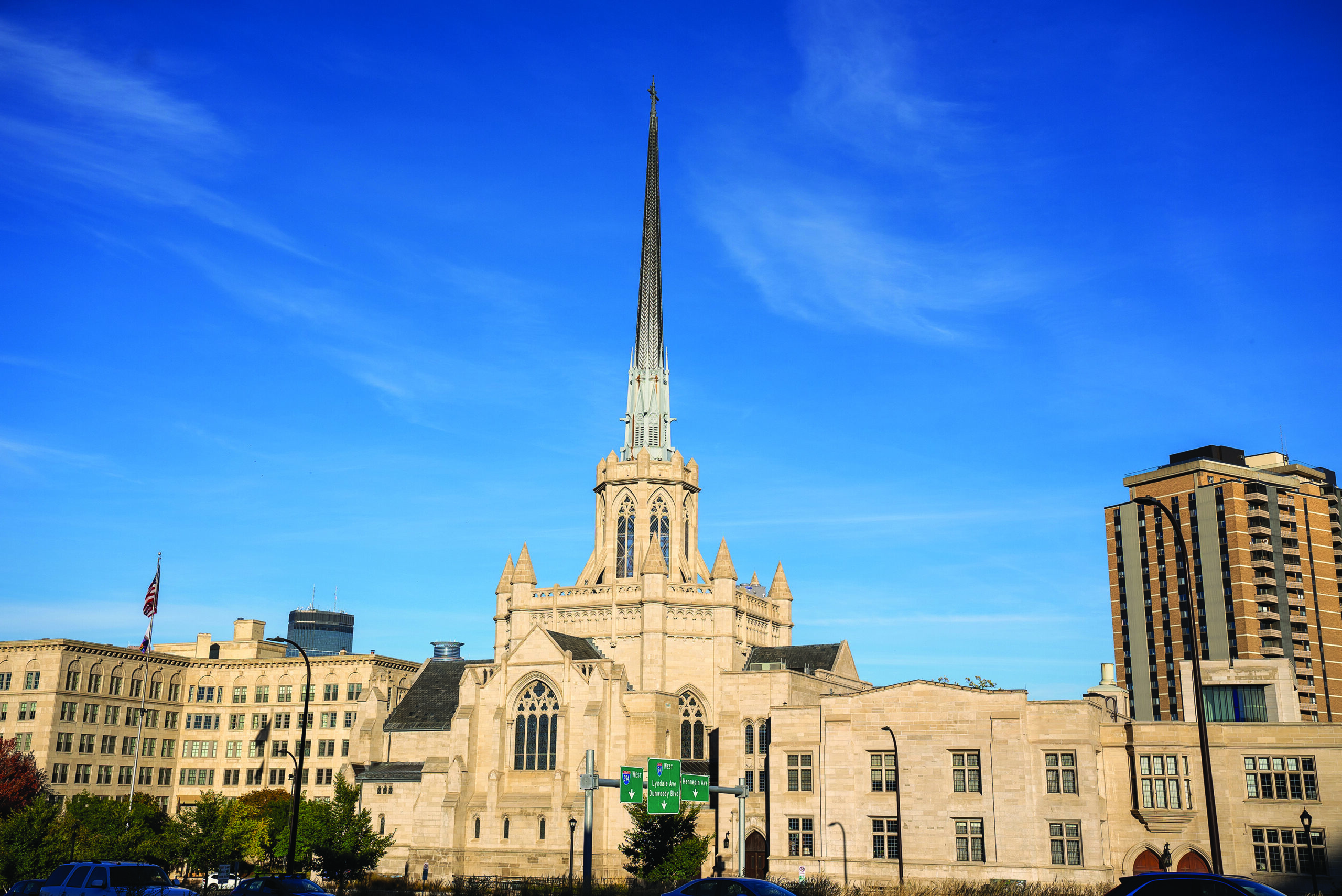With its towering spire, Hennepin Avenue United Methodist Church is one of the most striking of the line of monumental buildings along the Hennepin-Lyndale Crossroads.
A little-known fact is that it is home to one of Minneapolis’ most obscure yet valuable art collections. Hennepin United Methodist was built between 1914 and 1916 on land that Thomas Barlow Walker (T.B. Walker) had donated in 1910.
Hennepin United Methodist has a rich history of social justice, inclusion and stewardship. Consider its interfaith ministry, the Dignity Center, which specializes in offering strategies and support to help people achieve more stable lives.
Neighbors may recall Steeple People, also run by the church, which operated from 1979 to 2017 on Lyndale near Franklin. The store now operates in Stevens Square and is now called Old School by Steeple People.
The congregation originally worshiped at 10th Street and Hennepin in a beloved red brick church that was later razed. They relocated to Fowler Methodist Church, the building that is now the Scottish Rite Masonic Temple on Dupont and Franklin.
The lofty, cream colored building we know today on Hennepin-Lyndale attained its current form incrementally over the years: major additions include the education wing fronting the street in 1950 and the east entrance in 2003-2004.
The building itself is full of curios and delights that will impress and amuse visitors. An abundance of leaded and stained glass, woodwork, carvings, statuary, marble bathroom stalls, a cornucopia of antique hardware, lighting and other fittings are among the numerous minute delights to be savored there.
Perhaps the most notable is the artwork gifted to the church by T.B. Walker.
T.B. Walker
T.B. Walker originally came to Minneapolis from Ohio and worked a variety of jobs along the way — even applying an assistant professorship of mathematics at the University of Wisconsin — before settling on a career in lumber and real estate. An early developer of St. Louis Park, Walker owned large tracts of land throughout the country for use in lumber production, including the land that is now occupied by the lake-cottage haven of Walker, Minnesota.
This is the same T.B. Walker of the Walker Art Center and the Walker branch of the Hennepin County Library. In fact, Walker was one of the founders of the Minneapolis Public Library in 1885. Art and learning were a passion for him.
A man of the 19th century, Thomas Walker had eclectic tastes. His collection included a diversity of Asian art such as jades, bronzes, porcelains and ceramics, Southeast Asian artifacts, ivories, textiles and rugs. T.B. Walker’s art collection included old masters, as well as what were then-contemporary works in various genres.
Naturally, given the Walker Art Center’s contemporary art mission, Walker’s original collection doesn’t quite fit in thematically today.
The Evolution of the Walker Art Center
Although the Walker Art Center is the best-known fruit of Walker’s efforts to promote the appreciation of fine art, it owes its lineage to earlier galleries operated by T.B. Walker personally.
Repeatedly overruled in his attempts to convince the city to operate a public art gallery, Walker opened one in his own home on 8th and Hennepin (the site of the State Theatre today) in 1879.
With 20 paintings, it has been claimed to have been the first gallery between Sacramento and Pittsburgh.
When Walker moved to Lowry Hill in 1917 after purchasing the late Thomas Lowry’s original house between Vineland and Groveland, he kept the Walker Galleries downtown operating.
T.B. Walker offered his collection and the Lowry site to the city of Minneapolis in 1918. Prior to that the galleries were privately run.
In 1927 he built the Walker Museum in a Moorish style on the site of the present-day Walker Art Center, adjacent to his new home. Walker Art Galleries opened on Lyndale Avenue on May 21, 1927. T.B. Walker died on July 28, 1928.
The T.B. Walker Foundation turned the Walker Art Galleries over to the Minnesota Arts Council, who in turn made a petition to the WPA Federal Arts Projects to transform the galleries into the Walker Art Center. It was the largest of the WPA Community Art Centers. The T.B. Walker Foundation reclaimed the running of the Art Center when the federal program ended in 1942. The present museum is the result of a 1971 replacement of the then-remodeled 1927 building, and another 2005 addition that occupies the site where the Lowry house stood.
The challenge was where to house Walker’s traditional collection of artworks.
A Permanent Home
In 1918 Walker donated 24 of his paintings with religious themes to Hennepin United Methodist, which now reside in a handsome room constructed for the purpose.
The paintings vary in style, from intensely realistic to flattened, stylized work: the palettes are bright as well as muted. They also vary in size, from only a few feet across to wall-size scenes. The gallery is open whenever the church is, and all that is required is to open the door.
Although a collection of 15th to 19th century works brought over from Europe — mostly sight unseen — may seem distant from the experimental and contemporary avante garde on view at the Walker Art Center, the spaces are actually a continuation of T.B. Walker’s vision that art should be accessible to all and that its ability to challenge and enlighten are vital to a city’s health.






